商务契约关系
businesscontractualrelationships商务契约关系oue3
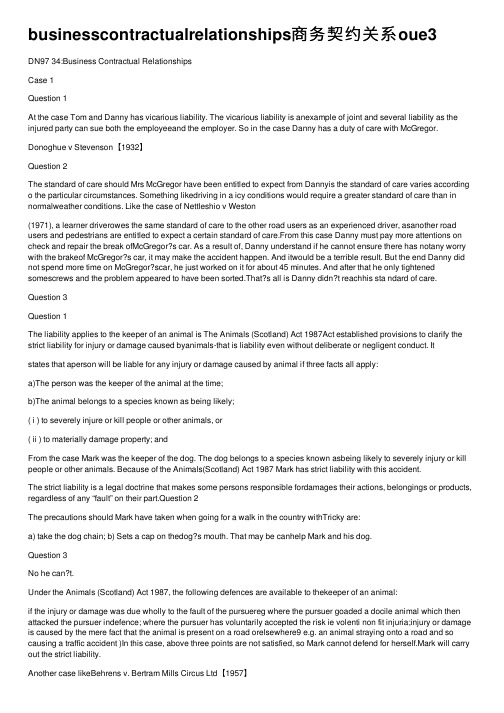
businesscontractualrelationships商务契约关系oue3DN97 34:Business Contractual RelationshipsCase 1Question 1At the case Tom and Danny has vicarious liability. The vicarious liability is anexample of joint and several liability as the injured party can sue both the employeeand the employer. So in the case Danny has a duty of care with McGregor. Donoghue v Stevenson【1932】Question 2The standard of care should Mrs McGregor have been entitled to expect from Dannyis the standard of care varies according o the particular circumstances. Something likedriving in a icy conditions would require a greater standard of care than in normalweather conditions. Like the case of Nettleshio v Weston(1971), a learner driverowes the same standard of care to the other road users as an experienced driver, asanother road users and pedestrians are entitled to expect a certain standard of care.From this case Danny must pay more attentions on check and repair the break ofMcGregor?s car. As a result of, Danny understand if he cannot ensure there has notany worry with the brakeof McGregor?s car, it may make the accident happen. And itwould be a terrible result. But the end Danny did not spend more time on McGregor?scar, he just worked on it for about 45 minutes. And after that he only tightened somescrews and the problem appeared to have been sorted.That?s all is Danny didn?t reachhis sta ndard of care. Question 3Question 1The liability applies to the keeper of an animal is The Animals (Scotland) Act 1987Act established provisions to clarify the strict liability for injury or damage caused byanimals-that is liability even without deliberate or negligent conduct. Itstates that aperson will be liable for any injury or damage caused by animal if three facts all apply:a)The person was the keeper of the animal at the time;b)The animal belongs to a species known as being likely;( i ) to severely injure or kill people or other animals, or( ii ) to materially damage property; andFrom the case Mark was the keeper of the dog. The dog belongs to a species known asbeing likely to severely injury or kill people or other animals. Because of the Animals(Scotland) Act 1987 Mark has strict liability with this accident.The strict liability is a legal doctrine that makes some persons responsible fordamages their actions, belongings or products, regardless of any “fault” on their part.Question 2The precautions should Mark have taken when going for a walk in the country withTricky are:a) take the dog chain; b) Sets a cap on thedog?s mouth. That may be canhelp Mark and his dog.Question 3No he can?t.Under the Animals (Scotland) Act 1987, the following defences are available to thekeeper of an animal:if the injury or damage was due wholly to the fault of the pursuereg where the pursuer goaded a docile animal which then attacked the pursuer indefence; where the pursuer has voluntarily accepted the risk ie volenti non fit injuria;injury or damage is caused by the mere fact that the animal is present on a road orelsewhere9 e.g. an animal straying onto a road and so causing a traffic accident )In this case, above three points are not satisfied, so Mark cannot defend for herself.Mark will carry out the strict liability.Another case likeBehrens v. Bertram Mills Circus Ltd【1957】The cases is about the plaintiffs, husband and wife, were both midgets and were onexhibition inside a booth in the funfair at Olympia, for which their manager hadobtained a licence from the defendants, when the booth was knocked down byelephants on their way to perform in the circus ring. A small dog, the property of thedaughter of the plaintiffs? manager,which, contrary to re gulations, had been broughtinto the funfair, had run out of the booth, snapping and barking at one of the elephants,which turned and went after the dog; some of the other elephants followed, and patsof the booth fell on the wife who received injuries. Evidence was given that thehusband and wife were exceptionally dependants upon each other. The court hold thecircus should have taken precautions to prevent the elephant from causing harm. Sohe circus should be liable for the injury caused to the plaintiff.Case 3Question 1Five defences available to a defender in a negligence action:a)Statutory justificationA person may have a good defence to an action in delict if he can show that hisacts are covered by statutory authority.b)Self-defenceSelf-defence is valid defence if the defender acted to preserve himself, his familyor his property, so long as the act was reasonable and in keeping with the nature ofthe threat. If a blow is struck in response only to verbal attract, there is no defence.c)CriminalityThe pursuer will be unable to claim damages if he and the defender were involvedin criminal activity.d)IllegalitySimilar to the criminality defense, a person will not be able to maintain a cause ofaction if he has to rely on couduct which is illegal or contrary to the public policy.e)Volenti non fit injuriaQuestion 2For the case …a?, Rab can defend by the defence of criminality. From the statutoryjustification:A person may have a good defence to an action in delict if he can showthat his acts are covered by statutory authority. So Rab can defend because he andJamesie were involved in criminal activity.For example:Ashton v. Turner 1981 RTR 54:The cited isHanlon v. Cuthbertson 1981:A female passenger in a taxi who was injured as a result of an accideng and he taxidriver argued contributory negligence because she was not wearing a seat belt whichotherwise have protected her in the accident. The court hold the pursuer should haveher damages reduced by ten percent as a result of the contributory negligence byherself.Question 3In the case …b? the bus driver can reduce liability by the defence of contributorynegligence. Margaret should have her damages reduced by 40% as a result becausethe action of the bus driver going across under the traffic light change to amber, didn?tbreak the law, but Margaret was not wearing her seat belt had broken the law.In case …c? cannot be successful, because in the sport, the action is normal and legal;actions refer to rule of games. In the case, Knockbuckie?s behavior was not out ofthose actions in the rule, thus he must be make obligation.。
商务契约范本,规范合作关系
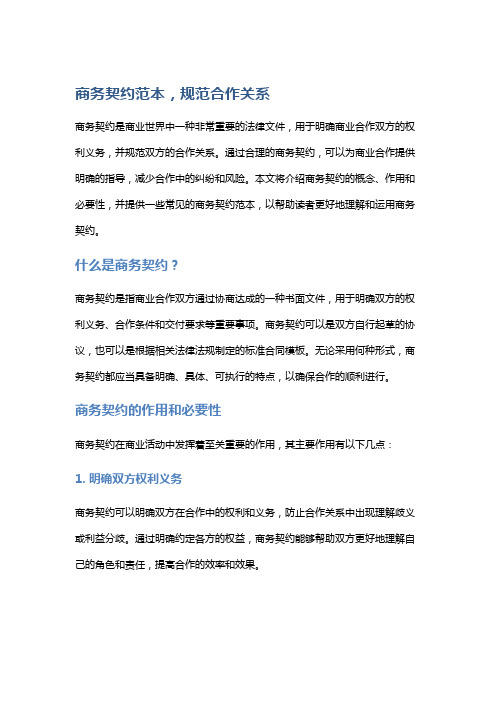
商务契约范本,规范合作关系商务契约是商业世界中一种非常重要的法律文件,用于明确商业合作双方的权利义务,并规范双方的合作关系。
通过合理的商务契约,可以为商业合作提供明确的指导,减少合作中的纠纷和风险。
本文将介绍商务契约的概念、作用和必要性,并提供一些常见的商务契约范本,以帮助读者更好地理解和运用商务契约。
什么是商务契约?商务契约是指商业合作双方通过协商达成的一种书面文件,用于明确双方的权利义务、合作条件和交付要求等重要事项。
商务契约可以是双方自行起草的协议,也可以是根据相关法律法规制定的标准合同模板。
无论采用何种形式,商务契约都应当具备明确、具体、可执行的特点,以确保合作的顺利进行。
商务契约的作用和必要性商务契约在商业活动中发挥着至关重要的作用,其主要作用有以下几点:1. 明确双方权利义务商务契约可以明确双方在合作中的权利和义务,防止合作关系中出现理解歧义或利益分歧。
通过明确约定各方的权益,商务契约能够帮助双方更好地理解自己的角色和责任,提高合作的效率和效果。
2. 规范合作流程商务契约不仅明确双方的权利义务,还规范了合作的具体流程和操作步骤。
商务合作通常涉及多个环节和部门,合作方通过制定合作流程,可以确保各个环节衔接顺利,提高合作的透明度和可控性。
3. 规避合作风险商务契约能够帮助合作双方识别和规避潜在的合作风险。
合同中通常包含风险分担、违约责任和争议解决等条款,为双方在合作过程中出现的纠纷提供了明确的解决途径,降低了合作风险并增加了合作的可靠性。
4. 保护商业利益商务契约有助于保护双方的商业利益。
合同中通常包括保密条款、知识产权等重要内容,确保商业机密和知识产权的安全性,防止不当流失和侵权行为,维护双方的合法权益。
5. 便于争议解决商务契约作为法律文件有法律效力,可以作为争议解决的依据。
当合作关系出现矛盾和纠纷时,若有完备的商务契约,就可以依照契约的约定进行协商、调解或诉讼,提高纠纷解决的效率和公正性。
商务契约关系2.1

Part 1Question 1:What is the difference between a contract of service and a contract for service? Contract of service•An employee-employer contract is a contract of service•is the term used when a person is considered an 'employee' of an organisation •Permanent employees have a contract of service with their employer. By definition, if a worker has a contract of service with an organisation, they are an employeeContract for services• A contractor-client contract is a contract for services•Relates to a person who is self-employed and who provides services to clients.A contract for services is a strictly business to business contract between two firms on a buyer and supplier basis. The client, or agency, is a buyer and the contractor’s limited company or Umbrella Company is the supplier. There is no question of any employment relationshipThe key rights and responsibilities of employee status under a contract of service.The worker is expected to work at a specific place during specific hours on specific days (even flexi-time has core hours). However, contract for service has not fixed time to do work.The worker must present themselves for work and cannot send someone else as a substitute. However, contract for service can taken place with other persons.Employees have statutory rights to holiday pay, sick pay, maternity and paternity rights and redundancy payments. However, contract for service has not holiday pay,sick pay, and so on.Employees have statutory rights regarding how they can be asked to leave their employment. On the contrary, contract for service has not these statutory rights.Employees enjoy a range of additional benefits, which can vary according to the employer, but might include company cars, private health insurance, staff canteens, health clubs and gyms and so on. On the contrary, it is unlucky that contract for service only has fixed wage.Employees are not personally liable for any errors they make when completing work for their employer, nor are they expected to make good in their own time. However, contract for service need to bear all of the responsibility when occur a accident at the work.There are three ways to test a person’s status•The integration test (综合测试)•The economic reality test (经济现实测试)•The control test (控制标准测试)•The totality of the working relationship is looked at in order to determine status so that individual knows whether they are or to what extent they are protected. As contract of services have more rights than contract for service. Cameron is belong to contract for service. Although, he wear suit code,and he also work in the other place at the same time. What’s more, at the busy, he could place to drive by his sister.Question 2:With reference to question 1 above, what kind of contract does Cameron have with tartan plc? Give reasons for your answer.According to Ready Mixed Concrete Ltd v Minister of Pensions and National Insurance (1968) reference has a relationship with the case one.The result of the case law is The Minister decided that Mr Latimer was employed under a contract of service.In his judgment, MacKenna J considered what is meant by a contract of service. He said “A contract of service exists if these three conditions are fulfilled.(i)The servant agrees that, in consideration of a wage or other remuneration, he will Provide his own work and skill in the performance of some service for his master. (ii) He agrees, expressly or impliedly, that in the performance of that service he will be subject to the other’s control in a sufficie nt degree to make that other master. (iii) The other provisions of the contract are consistent with its being a contract of service.In my view, Cameron is a contract for service. Owing to he is pertly free to refuse offers of work from the company and there is nothing in his arrangement with Tartan Transport PLC which prevents him from working for any other company. And sometimes make his sister on behalf of to work. Moreover, Cameron rights and interests enjoyed are few。
商务契约关系(Business Contractual Relationships 5.2
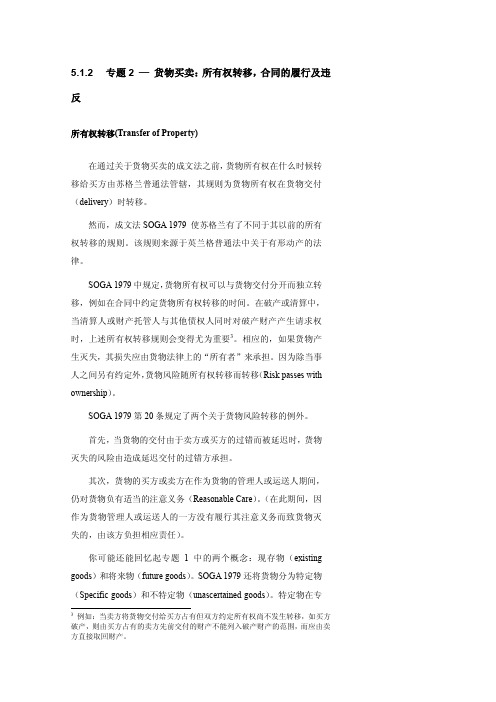
5.1.2 专题2 —货物买卖:所有权转移,合同的履行及违反所有权转移(Transfer of Property)在通过关于货物买卖的成文法之前,货物所有权在什么时候转移给买方由苏格兰普通法管辖,其规则为货物所有权在货物交付(delivery)时转移。
然而,成文法SOGA 1979 使苏格兰有了不同于其以前的所有权转移的规则。
该规则来源于英兰格普通法中关于有形动产的法律。
SOGA 1979中规定,货物所有权可以与货物交付分开而独立转移,例如在合同中约定货物所有权转移的时间。
在破产或清算中,当清算人或财产托管人与其他债权人同时对破产财产产生请求权时,上述所有权转移规则会变得尤为重要3。
相应的,如果货物产生灭失,其损失应由货物法律上的“所有者”来承担。
因为除当事人之间另有约定外,货物风险随所有权转移而转移(Risk passes with ownership)。
SOGA 1979第20条规定了两个关于货物风险转移的例外。
首先,当货物的交付由于卖方或买方的过错而被延迟时,货物灭失的风险由造成延迟交付的过错方承担。
其次,货物的买方或卖方在作为货物的管理人或运送人期间,仍对货物负有适当的注意义务(Reasonable Care)。
(在此期间,因作为货物管理人或运送人的一方没有履行其注意义务而致货物灭失的,由该方负担相应责任)。
你可能还能回忆起专题1中的两个概念:现存物(existing goods)和将来物(future goods)。
SOGA 1979还将货物分为特定物(Specific goods)和不特定物(unascertained goods)。
特定物在专3例如:当卖方将货物交付给买方占有但双方约定所有权尚不发生转移,如买方破产,则由买方占有的卖方先前交付的财产不能列入破产财产的范围,而应由卖方直接取回财产。
题1中也描述过其内容。
不特定物(unascertained goods)是指在合同成立时尚未指定并就其达成一致的货物。
推荐-商务契约关系1hnd 精品
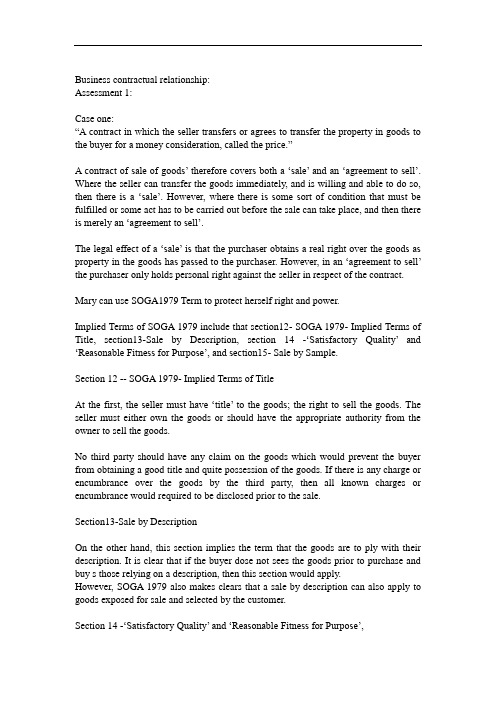
Business contractual relationship:Assessment 1:Case one:“A contract in which the seller transfers or agrees to transfer the property in goods to the buyer for a money consideration, called the price.”A contract of sale of goods’ therefore covers both a ‘sale’ and an ‘agreement to sell’. Where the seller can transfer the goods immediately, and is willing and able to do so, then there is a ‘sale’. However, where there is some sort of condition that must be fulfilled or some act has to be carried out before the sale can take place, and then there is merely an ‘agreement to sell’.The legal effect of a ‘sale’ is that the purchaser obtains a real right over the goods as property in the goods has passed to the purchaser. However, in an ‘agreement to sell’the purchaser only holds personal right against the seller in respect of the contract.Mary can use SOGA1979 Term to protect herself right and power.Implied Terms of SOGA 1979 include that section12- SOGA 1979- Implied Terms of Title, section13-Sale by Description, section 14 -‘Satisfactory Quality’ and ‘Reasonable Fitness for Purpose’, and section15- Sale by Sample.Section 12 -- SOGA 1979- Implied Terms of TitleAt the first, the seller must have ‘title’ to the goods; the right to sell the goods. The seller must either own the goods or should have the appropriate authority from the owner to sell the goods.No third party should have any claim on the goods which would prevent the buyer from obtaining a good title and quite possession of the goods. If there is any charge or encumbrance over the goods by the third party, then all known charges or encumbrance would required to be disclosed prior to the sale.Section13-Sale by DescriptionOn the other hand, this section implies the term that the goods are to ply with their description. It is clear that if the buyer dose not sees the goods prior to purchase and buy s those relying on a description, then this section would apply.However, SOGA 1979 also makes clears that a sale by description can also apply to goods exposed for sale and selected by the customer.Section 14 -‘Satisfactory Quality’ and ‘Reasonable Fitness for Purpose’,Satisfactory QualityIn English law, there was previously an onus on the purchaser to ensure that goods were of a reasonable quality and suitable for any specific purpose required –the caveat emptor rule.In Scottish law, there was a principle that a sale of goods was a contract of good faith.Section 14 only applies where goods are sold in the course of a business so it only covers the situation where the seller is in business. It does not cover private sales although the status of the buyer is irrelevant. Section 14 applies to business buyers as well as to private buyers.The quality of goods includes their state and conditions and this would therefore means that if goods are advertised as in a sale , or seconds etc, this could have some effect on quality to be expected. There are factors that are listed in section 14 of SOGA 1979 as potentially relevant in appropriate cases :( 1)Fitness for the purpose for which goods of the kinds in question are monly supplied(2)Appearance and finish (3)Freedom form minor defect (4) Safety (5) Durability.Reasonable Fitness for PurposeUnder section 14 of SOGA 1979, there is an implied term that the goods are reasonable fit for the purpose, whether or not that is purpose for which such goods are monly supplied.In the case, Mary’s tumble dryer has quality problems and line installation defects caused by fire. This does not conform to the provisions of product safety. Because this product’ defects cause serious consequences. Of course, the hairdryer to use only two months on the problems that the hairdryer is not durability. Hence,Mary could use Section 14 -‘Satisfactory Quality’ and ‘Reasonable Fitness for Purpose’ because that Mary’s situation conforms to the content that the law stipulate.Section15- Sale by SampleIn this section there are two implied terms:That the bulk will correspond with the sample in quality: and that the goods will be free from any defect, marking them unsatisfactory, which would not be apparent on reasonable examination of the sample.Case two:Charlie can't use the SOGA1979 bill rights, because Charlie did not directly buy tumble dryer.Charlie can use the Law of Delict to protect his own power,the Law of Delict, like the law of contract , is a part of the law of obligations. A delict has been defined as: “a civil wrong mitted by a person in deliberate or negligent breach of a legal duty, from which liab ility to make reparation for any consequential loss or injury may arise”General principles of Delictual liabilityAs noted above there must be three elements present:A loss or injury, such as physical or personal injury, the loss of earnings, nervous shock, distress, damage to a reputation.Caused by a legal wrong (wrong conduct)Caused by culpa(fault, intentionally or negligently done) on the part of the wrongdoer.Charlie lung inhalation of smoke to his shock in this belongs to the serious loss. According to the case, Charlie is not negligence resulting in the fire is mainly because short circuit caused the fire.Charlie can also use the Consumer Protection Act 1987to protect his rights and interests.It contains importance extension of the privity of contract rights for consumers if goods are unsafe, so that rights also exist directly against producers and those who hold themselves out as producers.The consumer protection act 1987 deal with three main aspects of consumer protection: product liability, customer safety and misleading pricing.Product liabilityPart one of the customer protection act 1987 transport the product liability directive into the UK law.part 1 of the establishes is a principle of strict liability relating to defective products which cause damages to other property and injure to people who were injured as a result of using the product or who came into close contract with the product.Strict liability means that the plaintiff does not have to prove fault on the part of the defendant. The product liability section made producers liable for any damage done by defective products. The Act goes even further in ensuring that customers are protected from damage or injure caused by faulty goods.In the case, Charlie’s safety and healthy was threaten by the gas that he absorb in the fire. This event happened due to product defect. Therefore, this event belongs to the product liability act.Consumer safetyPart 2 of Consumer Protection Act 1987provides the safety provisions.It deal with consumer safety and allows the government to regulate the design, ponents and construction of goods which could, if defective cause injury. Charlie also fits the bill because it is due to product defects cause harm. what’s more, the tumble dryer damage his health in this event and there is a bad effect on his life. Therefore, this event is suiting to Part 2 of Consumer Protection Act 1987provides the safety provisions.Misleading pricingPart 3 of the Act makes it illegal to mislead consumes about the price of any good, service or facility. The provisions of this part are quite prehensive and cover such services as banking, gas and electricity supplies, telephone service, parking acmodation and all goodsCase 3:The boss’s word is not obe yed no clause exempting.The first does not conform to the provisions; this statement is not a fair statement. The Unfair Contract Terms Act 1977 ——regulates contracts by restricting the operation and legality of some contract terms. One of its most important functions is limiting the applicability of disclaimers of liability.Section17 UCTA1977covers attempts to exclude contractual liability in consumer and standard form contract.If a document is singed at the time of making the contract, its contents bee terms of that contract, regardless of whether they have been read or understood.If separate written terms are presented at the time a contract is made, for example by handing over ticket, those terms only bee part of the contract if it can be said that the recipient had reasonable notice of them. However an exemption clause is only incorporated into the contract if notice is given before or at the time of contracting.Case 4:Debtor –creditor –supplier agreement. Where the creditor is also the supplier of the goods. In these agreement where goods or services cost more than$100or less than $30000 the debtor can hold the creditor jointly and severally liable with supplier when he claims misrepresentation or breach of contract against the supplier –known as ‘ connected leader liability’.Examples where there would be a debtor-creditor-supplier agreement include purchases of goods from retailers where there is a pre-existing financing arrangement; hire-purchase arrangements where the finance is provided by a finance pany; and credit card transactions.Under section 75 of the CCA 1974 both the creditor and the supplier are jointly and severally liable in respect of any breach of contract. The consumer would therefore choose to claim against either the creditor or the supplier.The creditor and supplier may be the same person, and has links to a creditor or vendor who will provide loans to the vendor's customers, this is a very mon type of agreement generally suppliers belong to the intermediary in the debtor-creditor-supplier agreement, however section75 of the Act allows debit charges lenders and suppliers, If a breach of contract, plus 85 pages under section 75 Credit belongs to consumer creditor with supplier belongs to the same party this clause can Act 1974 Dave supplier creditor claims.。
商务契约关系Outcome1
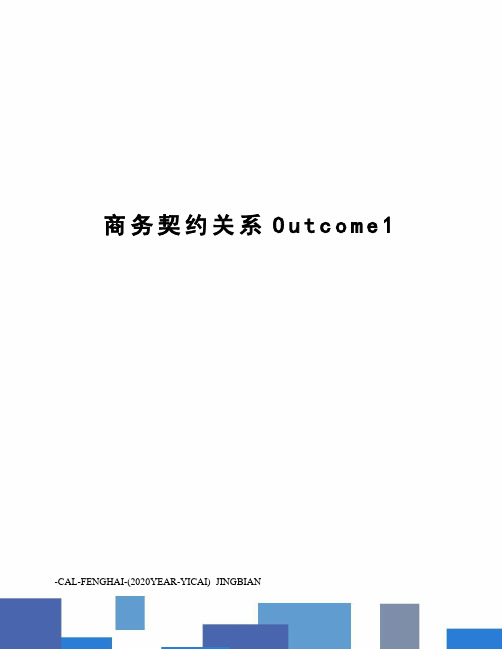
商务契约关系O u t c o m e1 -CAL-FENGHAI-(2020YEAR-YICAI)_JINGBIANCASE 1:Q1: Is Maggie entitled to bring a legal action against Thunderbolt & Lightning for selling her a defective tumble dryer and will it matter that she purchased the goods in a sale1.Yes, Maggie is entitled to bring a legal action against Thunderbolt & Lightning forselling her a defective tumble dryer in terms of the Sale of Goods Act 1979 (as amended).2.Thunderbolt & Lightning will be in breach of Section 14 of the 1979 Act. The storehas broken one of the implied terms of the Sale of Goods Act 1979 (Sections 12-15) which are always assumed to form part of every contract of sale.3.Section 14 also states that goods will be of satisfactory quality if they meet thestandard that a reasonable person would regard as satisfactory, taking account of any description of the goods, the price (if relevant) and all the other relevant circumstances. Section 14 lists five examples of quality that buyers can use to help them decide whether the goods that they have purchased fall below the expected standard of quality:fitness for all the purposes for which goods of the kind in question arecommonly suppliedappearance and finishfreedom from minor defectssafetydurabilityThe tumble dryer is not fit for its purpose, it is unsafe and it is not durable. The protection which Section 14 gives to buyers is only applicable in situations where the seller is selling the goods in the course of business. Maggie, of course, has purchased the goods from a business seller.4.Will it make a difference that Maggie purchased the goods in a sale No. The onlyexceptions will be when detects were specifically drawn to the buyer’s attention by the seller. Furthermore, if the buyer examined the goods before purchasing them and noticed any obvious defects, she/he will not have the protection of Section l4.5.More generally, the buyer’s claim that goods were not of satisfactory quality willbe defeated if the goods have been subject to wear and tear, the buyer hasmisused the goods or the buyer now has simply taken a dislike to the goods.6.Section 48A(3) of the Sale of Goods Act 1979 now states that there will be astrong presumption operating against the seller that if the goods develop defects within six months from the date of delivery to the buyer. Then they will probably have failed to meet the requirement of satisfactory quality.7.Candidates must be able to cite at least one of the following:Jackson v Rotax Motor and Cycle Co [1910]Grant v Australian Knitting Mills Ltd [1936]Mash and Murrell v Joseph I Emmanuel [196/], [1962]Bartlett v Sidney Marcus Ltd [1965]BS Brown & Son Ltd v Craiks Ltd[1970]Millars of Falkirk v Turpie [1976]Q2: What legal action, if any, can Charlie pursue as a result of the injuries that he has suffered1.Charlie will not be entitled to bring an action under Section 14 of the Sale ofGoods Act l979, because he does not have a contractual relationship withThunderbolt & Lightning.2.Charlie is in a much stronger legal position thanks to Part I of the ConsumerProtection Act l987 which allows him to pursue a civil claim for damages against the manufacturer of the tumble dryer in respect of his injuries. Part l of theConsumer Protection Act establishes a regime of strict liability in relation todefective products which cause damage to other property and/or injuries topeople who were injured as a result of using the product or who came into close contact with the product. Strict liability automatically presumes that the defect in the product must be the fault of the producer of the goods. The manufacturer must come up with a credible explanation to show why she/he is not to blame for the injuries or loss that the pursuer (Charlie) has suffered.3.The 1987 Act applies to dangerous products which are capable of causingdamage to the pursuer’s property or cap able of causing the pursuer to suffer some sort of personal injury. The fact that the product is not working properly will not give a pursuer the right to raise an action against the defender. Many products are defective without being dangerous in any way.Q3: Do you think that Thunderbolt & Lightning will be able to escape liability to Maggie by claiming that the manufacturer was responsible for the defects in the goods1.No. Thunderbolt & Lightning’s attempt to escape liability to Maggie by claimingthat the manufacturer was responsible for the defects in the goods will fall foul of the concept of strict liability in the Sale of Goods Act 1979.2.The buyer’s contract is with the seller and it is irrelevant to the buyer whetherthe defect has been caused by a manufacturing fault or not. The seller’s liability is said to be strict in the sense that the buyer does not have to prove fault orblame on the seller’s part.3. A seller can in turn sue the manufacturer for supplying it with defective goods ifthe buyer has successfully sued him/her for defects in the goods. The buyer may have suffered a personal injury or his/her property may have been damaged as a result of using the defective goods. The seller will have to compensate the buyer for any injuries suffered or any damage caused as a result of using the goods. So, compensation could be awarded for the destruction caused to Maggie’s kitchen and clothing in the appliance at the time of fire.4.Manufacturing guarantees may also give an indication as to the length of timethat a buyer can expect the goods to meet the appropriate standard of quality.This might be a strong indication of a major defect. Section 14 of the Sale ofGoods Act l979 states that manufacturing guarantees are directly enforceable against the manufacturer and any person (Thunderbolt & Lightning) who uses a guarantee to sell or market the goods to a consumer.Q4: Do you think that Thunderbolt & Lightning will be able to rely on the above exclusion clause to escape any potential liability to Maggie1.Thunderbolt & Lightning’s attempt to rely on the exclusion clause to escape anypotential liability to Maggie will fail miserably.2.Such an exclusion clause is null and void because the store is attempting toexclude its liability for personal injuries which it simply cannot do.3.Any attempt by the store to exclude or limit its liability in relation to Section 14of the Sale of Goods Act 1979 will be automatically void in terms of Section 20 of the Unfair Contract Terms Act 1977.4.Furthermore, there is a general provision in Section 16 of the Unfair ContractTerms Act 1977 which renders null and void any attempt by an individual toexclude his/her liability for death or personal injuries.5.Maggie is a consumer buying goods for her own private purposes and thestrongest possible protection is extended to consumers in terms of 1977 Act. 6.Additionally, the store’s exclusion clause could be challenged under the UnfairTerms in Consumer Contracts Regulations 1999. The Regulations apply a test of fairness before exclusion or limitation clause can be regarded as void andunenforceable. With regard to the issue of excluding or limiting liability for death or personal injury, the Regulations state that such terms may be unfair whereas the Act makes these automatically void.Q5: Presuming that Maggie’s legal action is successful, what remedies will she be entitled to claim against Thunderbolt & Lightning1.If Maggie’s legal action is successful, she will be entitled to claim the remedies ofrescission . cancellation of the contract of sale for material breach (supplying goods of unsatisfactory quality) and damages as per Section 15B of the Sale of Goods Act 1979.2.There are various remedies:rescissionreduction in the price of the goodreplacement of the goodsrepair the goodsCase 2Q1: What Act of Parliament covers consumer credit and how would you define a consumer credit agreement1.The Consumer Credit Act 1974 (as amended) regulates the consumer creditindustry.2.Section 8 of the l974 Act lays down a definition of a regulated consumer creditagreement. Such an agreement is a personal credit agreement by which thecreditor provides the debtor with credit not exceeding £25,000. A corporatebody (company, a limited partnership or a limited liability partnership) cannot bea party to a consumer credit agreement.Q2: By reference to Section 75 of the Consumer Credit Act l974, describe the legal relationship between Marvellous Motors PLC and Alba Bank.1.Marvellous Motors PLC has a debtor-creditor-supplier arrangement with the AlbaBank. Debtor-creditor-supplier agreements where the creditor and the supplier of goods may be the same person or where the supplier has links to a creditor who will provide credit to the supplier’s customers (the debtors). The supplier (Marvellous Motors PLC) in a debtor-creditor-supplier agreement is the agent of the finance house or the bank. This kind of arrangement benefits all three parties.The debtor is given access to a source of credit; the supplier can be confident of selling more goods because she/he is in a position to offer credit to potentialcustomers and the finance house/bank gets someone else (the supplier) to drum up custom on its behalf Debtor-creditor·-supplier agreements.2.Section 75 of the Act allows a debtor to sue either the creditor or the supplier inthe above arrangement for a breach of contract committed by the supplier(Marvellous Motors PLC). Section 75 makes the creditor and supplier jointly and severally liable to the debtor for any misrepresentations or breaches of contract committed by the supplier.Q3: What is the difference between a credit sale and a hire purchase agreement 1.In credit sales, the debtor will become the owner of the goods from the outset ofthe agreement. All the debtor has to do is make regular repayments of the debt owed to the creditor over the agreed credit period.2.In hire purchase sales, the debtor will not become the owner of goods until hehas paid the creditor all the instalments owed under the agreement. The debtor will be given an option to purchase the goods. Hire purchase can never involve the purchase of land.Q4: in what circumstances do debtors have the right to cancel a consumer credit agreement1.Section 67 of the Consumer Credit Act 1974 does allow a credit agreement to becancelled in certain situations. Credit agreements can only be cancelled if two conditions are met:if you, the debtor, entered into face to face discussions with the creditoror the creditor’s agents with the aim of entering a credit agreement; andthe signing of the credit agreement by both parties did not take place onthe creditor’s business premisesIf a debtor signed a credit agreement in his/her own home after discussions with the creditor’s agent, the debtor can take advantage of a cooling-off period. This period gives the debtor time to decide whether he wishes to cancel the agreement or not. Q5: What is the purpose of consumer credit licenses and will a business which applies for a license automatically be granted one1.The Consumer Credit Act 1974 established a licensing system which covers allactivities relating to the provision of credit. Businesses or individuals wishing to provide credit facilities to members of the public must be in possession of alicence issued by the Office of Fair Trading. Failure to obtain a licence means a business or an individual providing credit could face both civil and criminalpenalties. An unlicensed creditor may find they are unable to enforce theagreement against the debtor.2.Licences are not just issued to anyone.a.If you have previously broken the rules in the Consumer Credit Act 1974,you will probably not be issued with a licence.b.Criminal convictions for violence and dishonesty are likely to result in theapplicant being refused a licence.c.All licence holders must ensure that they conduct their businessesproperly. Any undesirable conduct on their part could mean that theOffice of Fair Trading may decide to suspend or, even more seriously,withdraw the licence.Case 3Q1: By re-labelling the bottles of Bulgarian chardonnay as champagne, what criminal offence is Wullie committing and which Act of Parliament will he be in breach of as a result of his activities1.Wullie will have committed the criminal offence of making a materially falseand misleading trade description as regards the origin of goods.2.He will be in breach of:a.Section 1 of the Trade Descriptions Act 1968 for making a false andmaterially misleading trade description in relation to goodsb.Section 2 of the Act gives definitions of various false and materiallymisleading trade descriptions andc.Section 3 explains what is meant by the word "false" in relation to atrade description.Q2: What defences are available to someone in Wullie’s position1. Section 24 of the Trade Descriptions Act 1968 provides the main defence to an accused in Wullie’s position:that the commission of the offence was due to a mistake, or due to relianceon information supplied to him, or to the act or default of another person, or to an accident, or due to some other cause beyond his control; andthat he took all reasonable precautions and exercised all due diligence toavoid the commission of such an offence by himself for any person under his controlWullie is not to be successful in any attempt to defend his actions given the deliberate nature of his crime.2.Candidates should be able to cite at least one of the following examples: Robertson v Dicicco [1972]Fletcher v Budgen [ I 974 ]Regina v Ford Motor Co [IQ74]Ford v Guild []990]Costello v Lowe [7990]。
HND商务契约关系3

The law of Delict, likes the law of Contract, is a part of the law of Obligations. A civil wrong committed by a person in deliberate or negligent breach of a legal duty, from which liability to make reparation for any consequential loss or injury may arise. Both the Scottish common law and statutory law apply to delictual obligations which are imposed by law. Delict is also known as the law of ‘civil wrong and applies to much of the same area of law as the English law of ‘tort’.As noted above there must be three elements present:·a loss or injury, such as physical or personal injury, the loss of earnings, nervous shock, distress, damage to a reputation·caused by a legal wrong ·caused by culpa (fault, intentionally or negligently done) on the part of the wrongdoer. Two exceptions will be discussed later:⑴ vicarious liability, where the defender is liable for the actions of another;⑵strict liability, where liability can arise without fault through statutory provision.If two or more persons have contributed to the delict then they are jointly & severally liable. Liability is transferred to the person benefiting or gaining by the actions of the wrongdoer. Vicarious liability of the Employer for his Employee’s Actions. Vicarious liability is an example of joint and several liability as the injured party can sue both the employee and the employer.2. NegligenceNegligence is the most common delict and an action in delict arises where harm is caused carelessly or inadvertently. For a claim to arise in negligence, the following points must be considered ·was a duty of care owed by the defender to the pursuer? And, if so, was there a breach of the duty of care? ·was the harm or loss caused by the defender’s breach of this duty of care?·whether the loss arising from the breach of duty was too remote.The duty of care must be owed by the defender to the Pursuer. The burden of proof Scott v London and St Katherine Dock Co 1861, Devine v Colvilles 1969the ‘Egg-shell’ or ‘Thin Skull’ rule Smith v Leech Brain and Co Ltd 19613. Defences in Delicta person has no right of action if they have expressly or by implication consented to something being done to them. However, such consent must be freely given and examples would include the implied consent of sportsmen, or express consent to a medical operation. There may also be a defence of necessity when saving lives or property.Volenti non fit injuria translates, It must be shown that the pursuer freely an voluntarily with full knowledge of the risk involved agreed to take that risk. The defender must establish that the pursuer had free choice and this would not apply if he acted out of duty or out of fear of losing his job. Refer to the case of Morris V Murray (1991).(b) A plea of contributory negligence and it is used where it is established that: the defender has been negligent BUT the pursuer’s own actions, in failing to take care for his own safety, have partly contributed to his injuries.Since the Law Reform Act 1945 it is available as a partial defence, and damages are reduced to such an extent as the court thinks ‘just and equitable’having regard to the pursuer’s share in responsibility for the damage. This share could be as much as 99%.The onus of proof is on the defender to establish the defence. Refer to the case of Sayers V Harlow Urban Council (1958).(c) A damnun fatale or ‘Act of God’would offer a complete defence. This would be some extraordinary event outside the control of man such as an earthquake. Mere heavy rainfall would not constitute a damnun fatale, even if it were exceptional.。
商务契约关系outcome2

商务契约关系outcome2
第一章契约的定义与种类
契约是指双方当事人就某种事项达成的一致意见,经过法律程序的认可后具有法律效力的协议。
契约种类包括口头契约、书面契约、法定契约和约定行为契约。
第二章商务契约的要素
商务契约包括因合同产生的交易,因此其要素较为复杂包括契约对象、契约条款、契约标的、契约期限、契约价款等。
第三章商务契约的履行和解除
商务契约是双方当事人通过协商达成的合同,需要履行合同的内容。
如果在履行过程中出现问题,双方可通过合同中的解除条款来解除合同。
同时,被迫终止合同所导致的损失需由违约方承担。
第四章商务契约的争议解决方式
商务契约争议的解决方式包括调解、仲裁和诉讼。
其中,调解是一种比较流行的解决方式,但需要双方当事人达成一致;仲裁是一种公正、快捷的解决方式,但需要确定仲裁人;诉讼是一种最后的解决方式,但程序较为繁琐且费用高。
第五章商务契约管理和风险控制
商务契约管理和风险控制是商务交易中不可忽视的一环。
在契约签订之前,需要对双方当事人进行风险评估和背景调查;在契约执行过程中,需要进行风险监控和风险防范,确保契约条款的履行。
结论
商务契约关系在商业交易中具有重要的地位,要素、履行、争议解决、管理和风险控制是其中必不可少的环节,需要双方当事人充分了解并遵守相关规定,确保商务契约秩序的稳定与发展。
推荐-商务契约关系1hnd精品
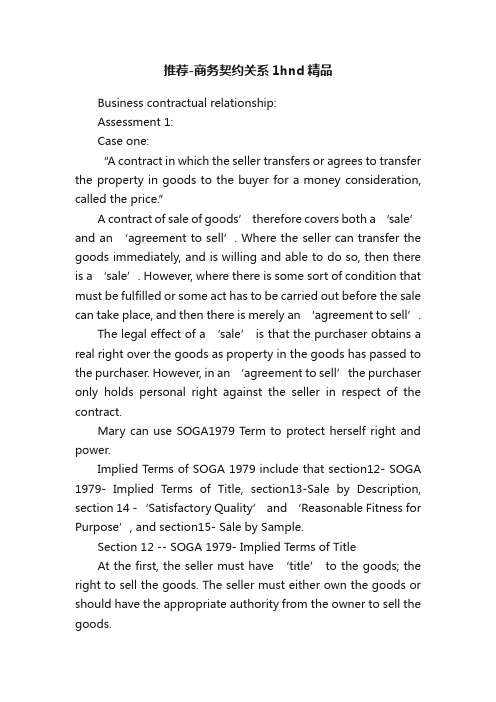
推荐-商务契约关系1hnd精品Business contractual relationship:Assessment 1:Case one:“A contract in which the seller transfers or agrees to transfer the property in goods to the buyer for a money consideration, called the price.”A contract of sale of goods’ therefore covers both a ‘sale’ and an ‘agreement to sell’. Where the seller can transfer the goods immediately, and is willing and able to do so, then there is a ‘sale’. However, where there i s some sort of condition that must be fulfilled or some act has to be carried out before the sale can take place, and then there is merely an ‘agreement to sell’.The legal effect of a ‘sale’ is that the purchaser obtains a real right over the goods as property in the goods has passed to the purchaser. However, in an ‘agreement to sell’the purchaser only holds personal right against the seller in respect of the contract.Mary can use SOGA1979 Term to protect herself right and power.Implied Terms of SOGA 1979 include that section12- SOGA 1979- Implied Terms of Title, section13-Sale by Description, section 14 -‘Satisfactory Quality’ and ‘Reasonable Fitness for Purpose’, and section15- Sale by Sample.Section 12 -- SOGA 1979- Implied Terms of TitleAt the firs t, the seller must have ‘title’ to the goods; the right to sell the goods. The seller must either own the goods or should have the appropriate authority from the owner to sell the goods.No third party should have any claim on the goods which would prevent the buyer from obtaining a good title and quite possession of the goods. If there is any charge or encumbrance over the goods by the third party, then all known charges or encumbrance would required to be disclosed prior to the sale.Section13-Sale by DescriptionOn the other hand, this section implies the term that the goods are to ply with their description. It is clear that if the buyer dose not sees the goods prior to purchase and buy s those relying on a description, then this section would apply.However, SOGA 1979 also makes clears that a sale by description can also apply to goods exposed for sale and selected by the customer.Section 14 -‘Satisfactory Quality’ and ‘Reasonable Fitness for Purpose’,Satisfactory QualityIn English law, there was previously an onus on the purchaser to ensure that goods were of a reasonable quality and suitable for any specific purpose required –the caveat emptor rule.In Scottish law, there was a principle that a sale of goods was a contract of good faith.Section 14 only applies where goods are sold in the course of a business so it only covers the situation where the seller is in business. It does not cover private sales although the status of the buyer is irrelevant. Section 14 applies to business buyers as well as to private buyers.The quality of goods includes their state and conditions and this would therefore means that if goods are advertised as in a sale , or seconds etc, this could have some effect on quality to be expected. There are factors that are listed in section 14 of SOGA1979 as potentially relevant in appropriate cases :( 1)Fitness for the purpose for which goods of the kinds in question are monly supplied(2)Appearance and finish (3)Freedom form minor defect (4) Safety (5) Durability.Reasonable Fitness for PurposeUnder section 14 of SOGA 1979, there is an implied term that the goods are reasonable fit for the purpose, whether or not that is purpose for which such goods are monly supplied.In the case, Mary’s tumble dryer has quality problems and line installation defects caused by fire. This does not conform to the provisions of product safety. Because this product’ defects cause serious consequences. Of course, the hairdryer to use only two months on the problems that the hairdryer is not durability. Hence,Mary could use Section 14 -‘Satisfactory Quality’ and ‘Reasonable Fitness for Purpose’ because that Mary’s situation conforms to the content that the law stipulate.Section15- Sale by SampleIn this section there are two implied terms:That the bulk will correspond with the sample in quality: and that the goods will be free from any defect, marking them unsatisfactory, which would not be apparent on reasonable examination of the sample.Case two:Charlie can't use the SOGA1979 bill rights, because Charlie did not directly buy tumble dryer.Charlie can use the Law of Delict to protect his own power,the Law of Delict, like the law of contract , is a part of the law of obligations. A delict has been defined as: “a civil wrong mitted by a person in deliberate or negligent breach of a legal duty, from which liab ility to make reparation for any consequential loss orinjury may arise”General principles of Delictual liabilityAs noted above there must be three elements present:A loss or injury, such as physical or personal injury, the loss of earnings, nervous shock, distress, damage to a reputation.Caused by a legal wrong (wrong conduct)Caused by culpa(fault, intentionally or negligently done) on the part of the wrongdoer.Charlie lung inhalation of smoke to his shock in this belongs to the serious loss. According to the case, Charlie is not negligence resulting in the fire is mainly because short circuit caused the fire.Charlie can also use the Consumer Protection Act 1987to protect his rights and interests.It contains importance extension of the privity of contract rights for consumers if goods are unsafe, so that rights also exist directly against producers and those who hold themselves out as producers.The consumer protection act 1987 deal with three main aspects of consumer protection: product liability, customer safety and misleading pricing.Product liabilityPart one of the customer protection act 1987 transport the product liability directive into the UK law.part 1 of the establishes is a principle of strict liability relating to defective products which cause damages to other property and injure to people who were injured as a result of using the product or who came into close contract with the product.Strict liability means that the plaintiff does not have to prove fault on the part of the defendant. The product liability sectionmade producers liable for any damage done by defective products. The Act goes even further in ensuring that customers are protected from damage or injure caused by faulty goods.。
商务合作契约
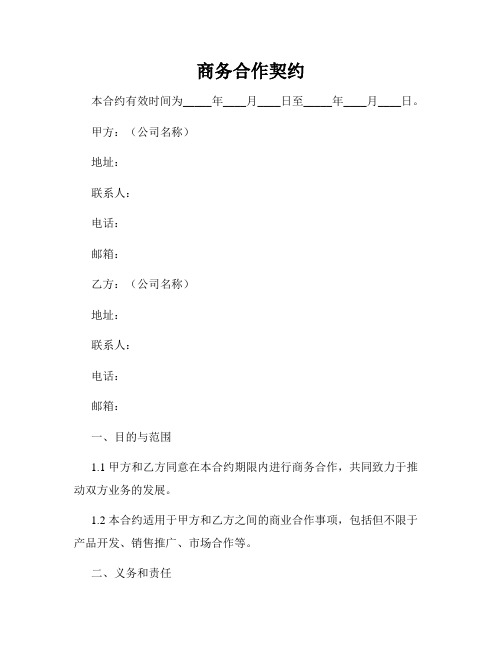
商务合作契约本合约有效时间为_____年____月____日至_____年____月____日。
甲方:(公司名称)地址:联系人:电话:邮箱:乙方:(公司名称)地址:联系人:电话:邮箱:一、目的与范围1.1 甲方和乙方同意在本合约期限内进行商务合作,共同致力于推动双方业务的发展。
1.2 本合约适用于甲方和乙方之间的商业合作事项,包括但不限于产品开发、销售推广、市场合作等。
二、义务和责任2.1 甲方责任:(1)提供有关产品或服务的详细信息,确保所提供的资料真实准确;(2)按照约定的时间和要求提供产品或履行服务;(3)保护乙方的商业机密,并确保合作中的信息安全;(4)不得擅自解除或变更本合约,除非经双方协商一致。
2.2 乙方责任:(1)根据甲方要求提供所需的技术支持和市场推广方案等;(2)遵守甲方的商业机密保护规定;(3)按照甲方的指导和要求完成工作任务;(4)不得向非合约相关人士透露或复制与甲方合作相关的信息。
三、合作方式与期限3.1 双方将按照约定的方式进行合作,并明确合作期间为本合约有效期。
3.2 如果任何一方希望终止合作,应提前______天书面通知对方,并友好协商解决相关问题。
四、商业机密保护4.1 除非获得对方明确书面许可,双方不得向任何第三方透露或提供对方的商业机密信息。
4.2 双方对商业机密负有保密义务,在合作关系终止后仍然有效,不因本合约的解除而改变。
4.3 如有违反机密保密义务的情况,违约方将承担相应的法律责任。
五、合作期间的技术支持与培训5.1 甲方应向乙方提供必要的技术支持和培训,保证乙方能够熟练运用所提供的技术和产品。
5.2 甲方提供的技术支持和培训应在合理的时间内完成,并确保质量达到相关要求。
六、合约费用与支付方式6.1 双方商定合作费用为______,具体支付方式为______。
6.2 合作费用应在双方签署本合约后的______天内支付完成。
如延迟支付,应按照约定支付滞纳金。
商务契约关系 outcome2

Outcome 2Case31Employers have the right to write a written statement to the employees. The written statement is not a contract. The written statement include your name, employee name, data of your stat working, wages, detail working and leave and so on. If the employers change the statement, they must give notice within one month.2 Sharon has the right to charge the company. Because the company isn’t have enough training experience. Sam has an obligation to create a safe working environment. Shredders a re dangerous goods. Consumer protection act 1987, employer’s liability(defective equipement) act 1969. 3. The company can stop David close to his customers. Because it is a illegal behavior and break the law. Customers belong to the company, not belong to David. Sale by ERA 1996, He must compensate the company's losses.4. the employer’s duty :1)To pay wages2)To provide work3)To indemnity his employees4)To treat employees with trust and respectthe employee’s duty1)To provide personal service2)To provide loyal service3)The employee must not make secret profits.4)Acts with honesty and integrityCase41 sex, age marriage, belief, race●Jimmy suffers the age discrimination. Although age discrimination is becameillegal. Unless there is a council according to age discrimination to protect staff equality of opportunity.●Alison’s employer refuse or negligence for her work environment to create areasonable adjustment. So Alison suffers the Disability discrimination●Owing to Carmen pregnant so that the council refused to give her work. Carmenhas suffered the sex discrimination●Because of Bob’s complexion, he loses his job. Bob suffer discrimination bycolor.:Jimmy-age discriminationAlison-Disability Discrimination Act 1995Carmen-Sex Discrimination Act 1975Bob-Race Relations Act 1976。
HND商务契约关系复习
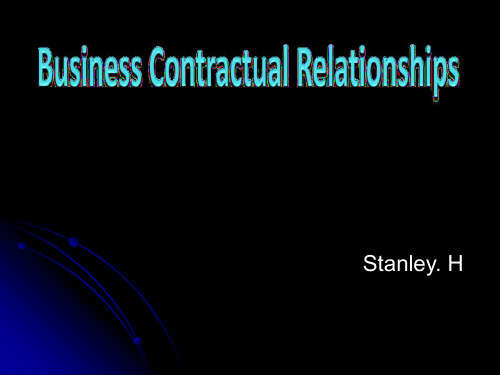
Key Point
Section 48(3)A of the Sale of Goods Act 1979 now states 将有 一个强力的推定去对抗卖家,如果瑕疵在交给买家6个月内生成, 卖家家可能被认为没有达到令人满意的质量. 然而, 卖家可以因买 家的篡改或滥用而使其无效 ♦ Jackson v Rotax Motor and Cycle Co [1910] ♦ Grant v Australian Knitting Mills Ltd [1936] ♦ Mash and Murrell v Joseph I Emmanuel [1961], [1962] ♦ Bartlett v Sidney Marcus Ltd [1965] ♦ BS Brown & Son Ltd v Craiks Ltd [1970] ♦ Millars of Falkirk v Turpie [1976]
Someone has a debtor-creditor-supplier arrangement with bank. Debtor-creditor-supplier agreements where the creditor and supplier 可能是同一人或是供应商has links to a creditor who will 提供借贷给 供应商的客户. 这是一种很普遍的协议. 一般说来, 供应商 在debtorcreditor-supplier agreement 中属于中介. 然而, Section 75 of the Act 允许 借方诉贷方与供应商如果供应商违反契约. Section 75 使贷方与 供应商对借方因供应商与事实不符的陈述负共同地和个别地责任, 在 有选择余地时非常有帮助 因为它可能无力履行
商务契约关系_Outcome_1
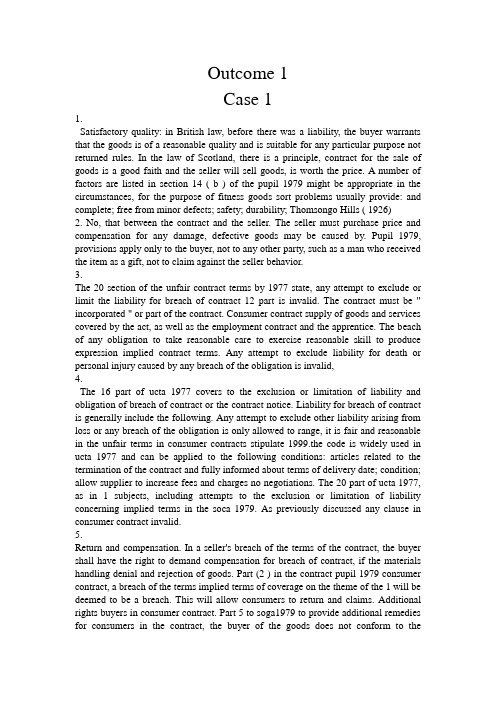
Outcome 1Case 11.Satisfactory quality: in British law, before there was a liability, the buyer warrants that the goods is of a reasonable quality and is suitable for any particular purpose not returned rules. In the law of Scotland, there is a principle, contract for the sale of goods is a good faith and the seller will sell goods, is worth the price. A number of factors are listed in section 14 ( b ) of the pupil 1979 might be appropriate in the circumstances, for the purpose of fitness goods sort problems usually provide: and complete; free from minor defects; safety; durability; Thomsongo Hills ( 1926)2. No, that between the contract and the seller. The seller must purchase price and compensation for any damage, defective goods may be caused by. Pupil 1979, provisions apply only to the buyer, not to any other party, such as a man who received the item as a gift, not to claim against the seller behavior.3.The 20 section of the unfair contract terms by 1977 state, any attempt to exclude or limit the liability for breach of contract 12 part is invalid. The contract must be " incorporated " or part of the contract. Consumer contract supply of goods and services covered by the act, as well as the employment contract and the apprentice. The beach of any obligation to take reasonable care to exercise reasonable skill to produce expression implied contract terms. Any attempt to exclude liability for death or personal injury caused by any breach of the obligation is invalid,4.The 16 part of ucta 1977 covers to the exclusion or limitation of liability and obligation of breach of contract or the contract notice. Liability for breach of contract is generally include the following. Any attempt to exclude other liability arising from loss or any breach of the obligation is only allowed to range, it is fair and reasonable in the unfair terms in consumer contracts stipulate 1999.the code is widely used in ucta 1977 and can be applied to the following conditions: articles related to the termination of the contract and fully informed about terms of delivery date; condition; allow supplier to increase fees and charges no negotiations. The 20 part of ucta 1977, as in 1 subjects, including attempts to the exclusion or limitation of liability concerning implied terms in the soca 1979. As previously discussed any clause in consumer contract invalid.5.Return and compensation. In a seller's breach of the terms of the contract, the buyer shall have the right to demand compensation for breach of contract, if the materials handling denial and rejection of goods. Part (2 ) in the contract pupil 1979 consumer contract, a breach of the terms implied terms of coverage on the theme of the 1 will be deemed to be a breach. This will allow consumers to return and claims. Additional rights buyers in consumer contract. Part 5 to soga1979 to provide additional remedies for consumers in the contract, the buyer of the goods does not conform to theprovisions of the contract at the time of delivery. The remedies available 48 soca 1979: repair or replacement goods; price; the termination of the contract.1。
104608business contractual relationships教学大纲
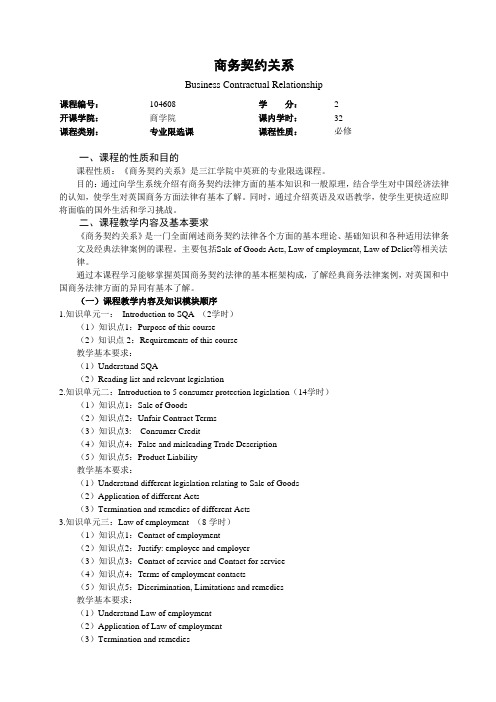
商务契约关系Business Contractual Relationship课程编号:104608 学分: 2开课学院:商学院课内学时:32课程类别:专业限选课课程性质:必修一、课程的性质和目的课程性质:《商务契约关系》是三江学院中英班的专业限选课程。
目的:通过向学生系统介绍有商务契约法律方面的基本知识和一般原理,结合学生对中国经济法律的认知,使学生对英国商务方面法律有基本了解。
同时,通过介绍英语及双语教学,使学生更快适应即将面临的国外生活和学习挑战。
二、课程教学内容及基本要求《商务契约关系》是一门全面阐述商务契约法律各个方面的基本理论、基础知识和各种适用法律条文及经典法律案例的课程。
主要包括Sale of Goods Acts, Law of employment, Law of Delict等相关法律。
通过本课程学习能够掌握英国商务契约法律的基本框架构成,了解经典商务法律案例,对英国和中国商务法律方面的异同有基本了解。
(一)课程教学内容及知识模块顺序1.知识单元一:Introduction to SQA (2学时)(1)知识点1:Purpose of this course(2)知识点2:Requirements of this course教学基本要求:(1)Understand SQA(2)Reading list and relevant legislation2.知识单元二:Introduction to 5 consumer protection legislation(14学时)(1)知识点1:Sale of Goods(2)知识点2:Unfair Contract Terms(3)知识点3: Consumer Credit(4)知识点4:False and misleading Trade Description(5)知识点5:Product Liability教学基本要求:(1)Understand different legislation relating to Sale of Goods(2)Application of different Acts(3)Termination and remedies of different Acts3.知识单元三:Law of employment (8学时)(1)知识点1:Contact of employment(2)知识点2:Justify: employee and employer(3)知识点3:Contact of service and Contact for service(4)知识点4:Terms of employment contacts(5)知识点5:Discrimination, Limitations and remedies教学基本要求:(1)Understand Law of employment(2)Application of Law of employment(3)Termination and remedies4.知识单元四:Law of Delict(2学时)(1)知识点1:Negligence(2)知识点2:Duty of care(3)知识点3:Remedies(4)知识点4:Business liability教学基本要求:(1)Understand Key words relating to the Law of Delict(2)Application of “Duty of Care”(二)课程的重点、难点及解决办法重点:本课程重点掌握包括Sale of Goods Acts, Law of employment, Law of Delict等相关法律的适用范围,违法惩罚,及法律救助条件;并通过案例分析,了解国内外商务法律的异同。
outcome2商务契约关系

outcome2 商务契约关系case1 1If you are an employee, i.e. you sign a contract of Service; theoretically, you havehigher position than those who sign contract for services, which are independent contractors.This is a hugely important distinction in UK employment law.C of S : employee-employer relationship. If a worker has a C of Swith an organization, they are an employee. Employees must present themselves for work and cannot send someone else as a substitute. They also have statutory rights to holiday pay, sick pay and so on. They are not liable for any errors they make when completing work for their employer.C FOR S; contractor-client relationship. The employer is generallynot liable for the vicarious acts of independent contractors.Contractors have a contractor for service with their client or agency. Contractor is required to abide by any health and safety agreements when working on the client;s site. 2…Cameron under the contract for service, because Cameron work for customer, give customer service , he is not an employer because he has not had the benefit of regular working patterns . 3…In term of state legal implication, the company needn’t reasonablefor Cameron, Because Cameron and the company are contract for service, there is no employment relationship. also Cameron is a independent contractor。
商业伙伴关系契约

商业伙伴关系契约本商业伙伴关系契约(下文简称“契约”),于_____年____月____日签署,由以下签约方(以下简称“各方”)共同约定以下条款,以确保双方在商业合作过程中的权益和责任。
第一条目的和范围1.1 本契约的目的在于明确各方商业合作的基本原则和规范,并为双方的权益提供保障。
1.2 本契约适用于各方在商业活动中的所有合作项目,涵盖但不限于产品销售、资源共享、市场推广等方面。
第二条合作内容2.1 合作项目的具体内容由各方另行协商确定,并以书面形式确认或通过电子邮件确认为有效。
2.2 合作期限为双方共同确认的起始日期至合同解除或履行完毕之日。
2.3 合作期间,各方应根据业务需要和合作协议的规定,保持相互沟通和协调,及时解决合作过程中出现的问题,以确保项目的顺利进行。
第三条责任和义务3.1 各方应本着互利共赢的原则,诚实守信地执行契约要求,不得有任何违反法律法规或商业道德的行为。
3.2 合作期间,各方应积极履行自身职责,保证合作活动的正常进行。
同时,各方应保护和维护他方的商业利益和商业机密,不得向任何第三方泄露有关商业合作的敏感信息。
3.3 如发生不可抗力事件,包括但不限于自然灾害、战争、政府管制等不可预见的事件,导致无法履行本合同的,各方应及时通知他方,并在合理的时间内协商解决办法。
在此期间,各方暂时免除因不可抗力事件而产生的责任。
第四条保密条款4.1 各方应对双方在商业合作过程中所了解到的商业机密严格保密,不得向任何第三方透露或泄露,除非获得对方书面授权。
4.2 商业机密包括但不限于商业计划、技术信息、客户信息、财务数据等,无论是口头或书面形式,都应受到严格的保护。
4.3 在合同解除或终止后,各方应归还对方提供的商业机密资料,并删除存储在电子设备上的相关信息。
第五条违约和解决纠纷5.1 若各方中的任何一方违反了本契约的约定,应承担相应的违约责任,并赔偿因此给对方造成的损失。
5.2 对于因合作活动产生的争议或纠纷,各方应尽力通过友好协商和合作解决。
商务契约关系课件 1
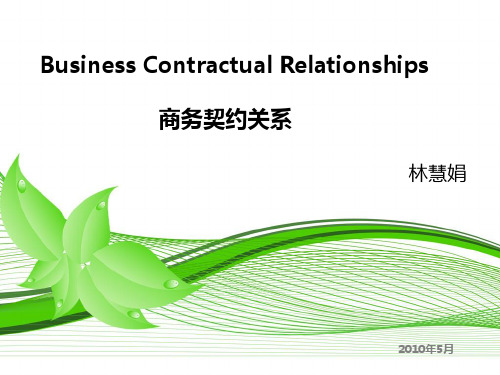
林慧娟
20nsumer protection
★Knowledge and/or skills
◆Sale of Goods ◆Unfair Contract ◆Consumer Credit ◆False and misleading Trade Descriptions ◆Product liability
Generic goods: a quantity of a commodity, such as thirty tons of sugar from an unspecified source. ——The contract is not terminated by frustration should the seller’ supply of goods be destroyed.
Section 1 : Sale of Goods
Topic 1: Legislation process
Sale of Goods Act 1893 →
Sale of Goods Act 1979 as amended(SOGA1979) → Sale and Supply of Goods Act 1994(SSGA1994) → Sale and Supply of Goods to Consumers Regulations 2002.
Topic 2: Why Legislate for Contracts of "Sale of Goods"?
Purchasers had very little protection as the onus was on them to ensure that the products did not have any problems or defects. (the Roman law maxim of Caveat emptor,or let the buyer beware 罗马法格言:货 物出门概不退还,一经出售概不负责,买者自负; 买者注意,买方小心。)
HND商务契约关系第二三部分
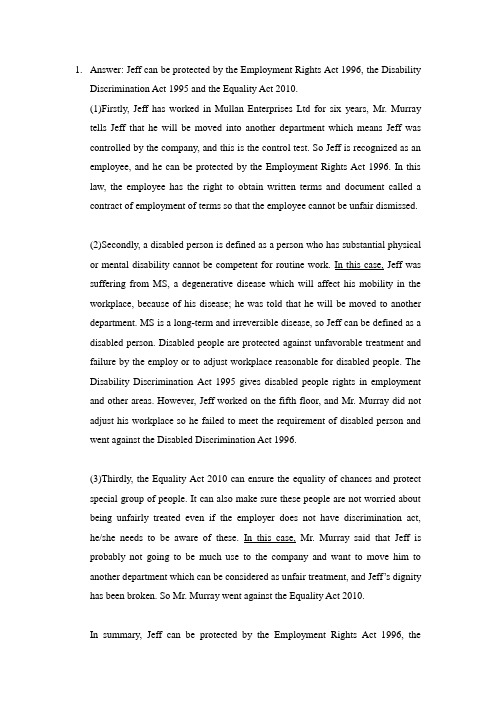
1.Answer: Jeff can be protected by the Employment Rights Act 1996, the DisabilityDiscrimination Act 1995 and the Equality Act 2010.(1)Firstly, Jeff has worked in Mullan Enterprises Ltd for six years, Mr. Murraytells Jeff that he will be moved into another department which means Jeff was controlled by the company, and this is the control test. So Jeff is recognized as an employee, and he can be protected by the Employment Rights Act 1996. In this law, the employee has the right to obtain written terms and document called a contract of employment of terms so that the employee cannot be unfair dismissed.(2)Secondly, a disabled person is defined as a person who has substantial physicalor mental disability cannot be competent for routine work. In this case, Jeff was suffering from MS, a degenerative disease which will affect his mobility in the workplace, because of his disease; he was told that he will be moved to another department. MS is a long-term and irreversible disease, so Jeff can be defined as a disabled person. Disabled people are protected against unfavorable treatment and failure by the employ or to adjust workplace reasonable for disabled people. The Disability Discrimination Act 1995 gives disabled people rights in employment and other areas. However, Jeff worked on the fifth floor, and Mr. Murray did not adjust his workplace so he failed to meet the requirement of disabled person and went against the Disabled Discrimination Act 1996.(3)Thirdly, the Equality Act 2010 can ensure the equality of chances and protectspecial group of people. It can also make sure these people are not worried about being unfairly treated even if the employer does not have discrimination act, he/she needs to be aware of these. In this case, Mr. Murray said that Jeff is probably not going to be much use to the company and want to move him to another department which can be considered as unfair treatment, and Jeff’s dignity has been broken. So Mr. Murray went against the Equality Act 2010.In summary, Jeff can be protected by the Employment Rights Act 1996, theEquality Act 2010 and the Disability Discrimination Act 1995.2.(1) Direct discrimination is because of the special nature of some people to giveunfair treatment. One person discriminates another person because of difference between them.(2) Indirect discrimination is not a direct difference. But the difference is in thesetting of a certain standard to make some people lose their chance. It looks like everyone is equal, but the standard is unreasonable.(3) In this case, Mr. Murray wants to move Jeff to another department because ofhis disease, Mr. Murray thought that he is no longer useful to the company which harms Jeff’s confidence and Jeff was treated differently from others. Through this can be judged by direct discrimination. When Mr. Murray know Jeff’s disease, he did not make any adjustment for him which will be considered as discrimination treatment and went against the Disability Discrimination Act 1995.3.(1)The Supreme Court found that the element of control that employer canexercise over the employee to determine the relationship between them. Firstly, Julia has a written statement of employment with the company. Secondly, Julia has been an employee in the company for 9 years and she is expected to completea set amount of hours every week which means she is controlled by the company,this is the control test. Thirdly, her company deals with her tax deductions, this is fiscal test, the fiscal test can decide whether the person run business on his/her own account/ personal account or accounts used in the process of work in Hall v Lorner(1992).(2) Julia can be dismissed fairly.According to section 98 the Employment Rights Act 1996, a reason is related to an employee’s conduct. Dismissal: a valid reason that they can justify arereasonably in the circumstance. In this case, Julia has worked for 9 years, her ability is good. However, she punched employees in the workplace when training them which will be very serious. In the Act, the employer dismisses an employee because employee has broken the terms of employee’s employment. So Julia can be dismissed. However, the employer should follow a fair disciplinary procedure before dismissing and give employee chance to explain and appeal. Before Julia was fired, she should be told and warned the bad behavior and the employer should tell the employee how serious the behavior was and show the damage to her.Case Law: The case Post Office v Liddiard (2001)The employee referred to football violence, his dismissal for reason was held to be unfair. The principle that employee cannot be dismissed without warning. That the employer can justify the employee’s behavior is so seriously and employee should be aware of the serious.The disciplinary procedure:①Interviewing any relevant witness②Considering any relevant documents③Inviting employee to attend disciplinary hearing and let him/her know in advance④The employee’s work record should be considered, if the employee is found to hare gross negligence⑤Informing the employee of the right to appeal.4.Tom is an accounting in Company E, he often makes mistakes during these twoyears he works. He usually provides false financial information which will lead toa large financial loss of company. So, Company E provided Tom two monthsaccounting training. But after training, Tom’s work is not improved. Not long ago,a staff reported the manager that tom hided drugs in the office. The manager foundevidence after work. Company E pointed out that Tom’s action damages company’s image. Tom should be dismissed because of his conduct. Tom broke the terms of employee’s employment. In addition, Tom is lack ability to his work, he cannot do accounting, So it is reasonable to dismiss Tom.5.Mary is pregnant. She applies for three months of maternity leave. But thecompany doesn’t approve. The manager tells Mary that if she insists on the maternity leave, she will be dismissed. At the same time, the employers need to reduce workforce. Mary is selected to redundancy because she is pregnant.Employer wants to dismiss Mary because of maternity leave. It breaches statutory employment rights. So it belongs to automatically dismissal. Mary is selected because of pregnant, and this also can be classed as an unfair dismissal.。
商务合作契约范式模式样式

商务合作契约范式模式样式商务合作契约一、合作目的与背景本合作契约旨在规范双方之间的商务合作关系,确立互相合作的权利和义务,达成互利共赢的目标。
二、合作主体甲方:(公司名称)地址:法定代表人:联系方式:乙方:(公司名称)地址:法定代表人:联系方式:三、合作内容1. 描述双方合作的具体项目或业务范围,包括但不限于:(1)提供产品或服务。
(2)共同研发新产品或服务。
(3)市场推广与销售相关事宜。
(4)其他合作内容。
2. 各方在合作过程中的具体责任和义务,包括但不限于:(1)甲方承担的责任与义务。
(2)乙方承担的责任与义务。
四、合作期限该合作契约自双方签署之日起生效,有效期为____年(具体年限)。
五、合作权益与利益分配1. 双方在合作中所获得的权益和利益的分配,由双方协商确定,并在本合作契约中明确表述。
2. 双方在合作期间发生的知识产权问题,由双方共同分享或协商解决。
六、合作费用与支付方式1. 合作费用的具体数额及支付方式,由双方在合作签订前达成一致,明确写入本合作契约。
2. 合作费用的支付时间和方式应根据合作进程的具体情况进行协商和确定。
七、违约责任1. 若双方中任何一方未履行本合作契约中的义务或违反合约约定,对方有权要求违约方承担相应的法律责任,并可解除本合作契约。
2. 对于因不可抗力因素导致的合作项目未能按时履行,双方应及时通知对方,并重新商定履行时间或调整合作方式。
八、保密协议1. 双方在合作期间及合作结束后均应对涉及商业机密、技术资料和合作细节等涉及到的信息予以保密。
2. 未经对方书面同意,任何一方不得向第三方披露或使用对方的商业机密和合作信息。
九、争议解决双方在合作过程中的任何争议应通过友好协商解决。
若无法协商解决,应提交至有管辖权的仲裁机构进行仲裁。
十、合作终止1. 任何一方可以在提前____个月书面通知对方的情况下解除本合作契约。
2. 合作终止后,双方应确保已完成的合作内容得到合理结算,并进一步确定合作终止后的其他事宜。
- 1、下载文档前请自行甄别文档内容的完整性,平台不提供额外的编辑、内容补充、找答案等附加服务。
- 2、"仅部分预览"的文档,不可在线预览部分如存在完整性等问题,可反馈申请退款(可完整预览的文档不适用该条件!)。
- 3、如文档侵犯您的权益,请联系客服反馈,我们会尽快为您处理(人工客服工作时间:9:00-18:30)。
School of Overseas Education, Sichuan UniversityHigher National Diploma Business ContractualRelationship(F84N34)Outcome 1Original Work StatementI hereby certify that my paper is an original work that has not been published elsewhere and does not contain any copyrighted material which is reproduced without permission of the original owner.Signature: ____________________Table of content1.Introduction (2)2. Contract of sale (2)3.Reject goods and Return it (3)4.a The mistake of the sales assistant (4)4.b The shop’s error (4)5.a Consumer Credit Act (5)5.b Joint liability (5)6.The damage protection (6)7.Conclusion (7)8. Reference (8)1. IntroductionThis report analyses the case and customer can protect his legal rights according to law..2. Contract of saleWe can defined sale that “a contract in which the seller transfers or agrees to transfer the property in goods to the buyer for a money consideration, called the price.”(SQA, 2014)A contract of sale include sale and agreement to sell.“Where the seller can transfer the good immediately, and is willing and able to do so, there is a sale.”“ where there is some sort of condition that must be fulfilled or some act has to be carried out before the sale can take place,there is a agreement to sell .”(SQA, 2014)The Validity Factors of contract of sale:(!)A minority of contracts have to be made in a particular forms.(2)Contract made not by duress or by mistake.(3)Some persons only have limited capacity to enter into contract.(4)Contract must be completed and precise in its terms.(5)Must not be illegal, immoral or contrary to public policy.(SQA,2013)In the case,the original price of the laptop is £599.99.But John speak with a sale in the store, he agree to reduce reduce £100. So John spent £499.99 to buy a laptop from Mega Tech Electronics. Then, John obtained the ownership of the laptop. So John put forward a offer to the store, then the store to accept the offer. They reached a consensus. John and the store entered into a “contract of sale”.3. Reject goods and Return itYes, John can reject the laptop and return it to the shop.First , John’s laptop is in a black casing,but he told the assistant he want to get a white model. This violated the section 11 of Consumer Rights Act 2015 . Every contract to supply goods by description is to be treated as including a term that the goods will match the description.(The National Archives, 2015) Second, John’s laptop has a large scratch on the screen, and his laptop missing keys on the keyboard. This is a quality problem. John can reject the laptop and return it to the shop, according to the section 9 in Consumer Rights Act 2015. Every contract to supply goods is to be treated as including a term that the quality of the goods is satisfactory.(The National Archives, 2015)In the case of Roberts & Co v Yule(1896), machinery merchants described his four-gas-engine need £47 10s to spent on working order .But the purchasers found that it is £55 10s . The count held that the buyers were entitled to reject the engine.(SQA, 2014). This case can support John reject the laptop and return it to the shop.4.a The mistake of the sales assistantNo, the sales assistant made a mistake.The normal rules would apply to sale goods and if the goods are of a reasonable quality etc, consumer know the goods situation or the seller would be entitled to the refuse of the purchase price because the buyer had simply changed his or her mind. (SQA, 2014)In the case, sale assistant did not told John about the laptop problems before he buy the laptop. John did not know this laptop has some problem. This violated the section 14 of Consumer Rights Act 2015 (The National Archives, 2015).So the shop should refund john or replace the laptop for him.4.b The shop’s errorThe section 20 of the Unfair Contract Terms Act 1977, covers attempts to exclude or restrict liability in relation to implied terms in CRA 2015. Those clauses are void in a consumer contract. (SQA, 2014)In the case, john bought a laptop in the shop.There is a consumer contract between John and the shop. If the shop rely on the sign about not giving refunds or replacements, the shop violate the Unfair Contract Terms Act 1977. So they can not do that.5.a Consumer Credit ActYes, John can be protected through joint liability , according to Consumer Credit Act 1974 .In the case, because John used a credit card when he bought the laptop. So John, the shop and the credit card company respectively become a debtor, supplier and creditor. This is a debtor-creditor-supplier agreement.Debtor-creditor-supplier agreement: Where the creditor is also the supplier of the goods. In these agreements where goods or services cost more than £100 or less than £ 30000 the debtor can hold the creditor jointly and severally liable with supplier when he claims misrepresentation or breach of contract against the supplier - known as “connected lender liability”. (SQA, 2014)In the case, the laptop is £499.99, so the agreement is effective.The section 75 in Consumer Credit Act 1974 both the supplier and the creditor are jointly and severally liable in respect of any breach of contact. (SQA, 2014)5.b Joint liabilityIf parties have joint liability, then they are each liable up to the full amount of the relevant obligation.I f there is breach of contract,the creditor and the supplier can't be ruledout,John can Sue suppliers and creditors.6. The damage protectionYes, Anna is protected by legislation according to Consumer Protection Act 1987.Duty of care: a legal obligation which is imposed on an individual requiring adherence to a standard of reasonable care while performing any acts that could foreseeably harm others. (SQA, 2014)In the case, Anna's laptop spontaneous combustion, and burned his fingers and table. So the company has a duty of care for Anna.Strict product liability is indicating to the liability of all the parties among the procession of manufacturing a product for damages caused by the product. (SQA, 2014)In the case, a laptop's spontaneous combustion caused Annie property and personal injury.So the store has liability for Anna.The onus of proof : Consumers have to prove that the product caused his injury and that he was using the product at the time of the incident in a normal manner. (SQA, 2014)The store may be do defense for himself, according to the onus of proof. But Anna is really normal use her laptops. And This incident caused personalinjury and property loss to her. The store can not rule out responsibility according to Consumer Protection Act 1987. The company need pay damage to Anna.7.0 Conclusion:This report analysis the customers’ legal right when they buy some quality problems of goods.8. ReferenceSQA (2014)Business Contractual Relationships(2ed edn), Beijing, China Modern Economic Publishing House.SQA (2013)Business Law : introduction (2ed edn), Beijing, China Modern Economic Publishing HouseThe National Archives, (2015) “Consumer Rights Act 2015”, the official home of UK legislation, (online) (cited October 22, 2015). Available from: /ukpga/2015/15/section/9/enacted。
